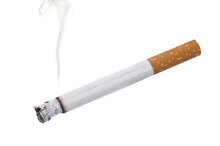How Dangerous Is Smoking a Pack Every Week?
Smoking has devastating health consequences, even if you smoke just a pack per week 12. An October 2005 study report published in "Tobacco Control" found that the relationship between smoking and adverse health consequences occurs even among people who smoke 1 to 4 cigarettes per day 1. The surgeon general has confirmed these findings, concluding there is no safe level of exposure to tobacco smoke -- including secondhand exposure.
If you are experiencing serious medical symptoms, seek emergency treatment immediately.
Coronary Heart Disease
Even at low levels of exposure, cigarette smoking increases the risk for cardiovascular disease. The surgeon general concluded in 2006 and again in 2010 that light smoking and secondhand exposure have immediate harmful effects on the body. This harm comes in the form of damage to the blood vessels and sets off chronic inflammation that fuels atherosclerosis, the most common cause of coronary heart disease. Smoking 1 to 4 cigarettes more than doubles the risk of dying from coronary heart disease compared to nonsmokers, according to the authors of the 2005 "Tobacco Control" study report 1.
- Even at low levels of exposure, cigarette smoking increases the risk for cardiovascular disease.
- The surgeon general concluded in 2006 and again in 2010 that light smoking and secondhand exposure have immediate harmful effects on the body.
Chronic Obstructive Pulmonary Disease
What Is Heavy Smoking?
Learn More
The authors of an October 2012 study report published in the journal "Chest" found that people exposed to secondhand smoke have more than double the risk for chronic obstructive pulmonary disease, or COPD, compared to nonsmokers not exposed to cigarette smoke at home or work. Given that even exposure to secondhand smoke significantly increases the risk for COPD, it is reasonable to conclude that light smoking has a similar or greater effect. Findings from a study published in February 2013 in "Respiratory Research" confirm this notion. The researchers report that past or current light smoking significantly increases the risk for developing chronic bronchitis, a form of COPD.
- The authors of an October 2012 study report published in the journal "Chest" found that people exposed to secondhand smoke have more than double the risk for chronic obstructive pulmonary disease, or COPD, compared to nonsmokers not exposed to cigarette smoke at home or work.
Lung Cancer
The researchers who conducted the study published in "Tobacco Control" in October 2005 reported a substantially increased risk of lung cancer among light smokers. Women in the study who smoked 1 to 4 cigarettes daily were 5 times more likely to develop lung cancer and men were 3 times more likely, compared to nonsmokers. Light smoking for a longer duration may be more harmful than heavy smoking for a shorter duration, according to the authors of a March 2006 study report published in "Cancer Epidemiology, Biomarkers & Prevention." A separate group of researchers reported in the December 2006 issue of the same journal that even light smokers and people who have reduced the number of cigarettes smoked daily experience high levels of exposure to cancer-causing chemicals from tobacco smoke 8.
- The researchers who conducted the study published in "Tobacco Control" in October 2005 reported a substantially increased risk of lung cancer among light smokers.
- A separate group of researchers reported in the December 2006 issue of the same journal that even light smokers and people who have reduced the number of cigarettes smoked daily experience high levels of exposure to cancer-causing chemicals from tobacco smoke 8.
Reproductive Effects
Does Smoking Cigarettes Stunt Growth?
Learn More
According to a 2006 surgeon general's report, exposure to secondhand smoke during pregnancy is a contributing factor to sudden infant death syndrome and low birth weight 5. The report also found that exposure to secondhand smoke during pregnancy may increase the risk for preterm delivery and childhood diseases, including cancer, leukemia, lymphoma and brain tumors. It is reasonable to conclude that light smoking has at least similar risks.
Light Smoking Shortens Your Life
The October 2005 "Tobacco Control" study found that smoking just 1 to 4 cigarettes per day significantly increases the risk of death 1. The 2006 surgeon general's report concluded that exposure to secondhand smoke leads to an earlier death 25. In the 2014 report, the surgeon general estimated that smokers' lives are shortened by a decade 2. If you quit smoking by age 40, the surgeon general estimates you can reduce that loss of years by 90 percent 2. Quitting by age 60 is estimated to reduce years of life lost by 40 percent.
Related Articles
References
- Tobacco Control: Health Consequences of Smoking 1-4 Cigarettes Per Day
- U.S. Department of Health and Human Services: The Health Consequences of Smoking -- A Report of the Surgeon General, 2004
- Centers for Disease Control and Prevention: Health Effects of Cigarette Smoking
- Circulation: Epidemiology and Prevention -- Cardiovascular Mortality and Exposure to Airborne Fine Particulate Matter and Cigarette Smoke
- U.S. Department of Health and Human Services: The Health Consequences of Involuntary Exposure to Cigarette Smoke -- A Report of the Surgeon General, 2006
- Chest Journal: Secondhand Smoke Exposure Predicted COPD and Other Tobacco-Related Mortality in a 17-Year Cohort Study in China
- Respiratory Research: Diverging Trends of Chronic Bronchitis and Smoking Habits Between 1998 and 2010
- Cancer Epidemiology, Biomarkers & Prevention: Cigarette Smoking and Lung Cancer -- Modeling Total Exposure and Intensity
- Centers for Disease Control and Prevention (CDC). Current Cigarette Smoking Among Adults In The United States. Office on Smoking and Health, National Center for Chronic Disease Prevention and Health Promotion. Updated November 18, 2019.
- American Lung Association. What’s In A Cigarette? ALA Smoking Facts. Updated August 20, 2019.
- Centers for Disease Control and Prevention (CDC). Recognize Signs Of Depression. Office on Smoking and Health, National Center for Chronic Disease Prevention and Health Promotion, Centers for Disease Control and Prevention. Updated April 1, 2019.
- Centers For Disease Control And Prevention (CDC). Smoking And Heart Disease And Stroke. Office on Smoking and Health, National Center for Chronic Disease Prevention and Health Promotion, Centers for Disease Control and Prevention. Updated January 28, 2019.
- Centers for Disease Control and Prevention (CDC). Heart Disease Facts. National Center for Chronic Disease Prevention and Health Promotion, Division for Heart Disease and Stroke Prevention. Updated December 2, 2019.
- Centers for Disease Control and Prevention (CDC). Infographics - Tobacco Use And Cardiovascular Disease. CDC Global Health. Updated May 29, 2018.
- Centers For Disease Control And Prevention (CDC). Fast Facts. Office on Smoking and Health, National Center for Chronic Disease Prevention and Health Promotion. Updated November 15, 2019.
- World Health Organization (WHO). Tobacco. WHO Fact Sheets. Updated July 26, 2019.
- Centers for Disease Control and Prevention (CDC). Current Cigarette Smoking Among Adults In The United States. Office on Smoking and Health, National Center for Chronic Disease Prevention and Health Promotion. Updated November 18, 2019.
- American Lung Association. What’s In A Cigarette? ALA Smoking Facts. Updated August 20, 2019.
- Centers for Disease Control and Prevention (CDC). Recognize Signs Of Depression. Office on Smoking and Health, National Center for Chronic Disease Prevention and Health Promotion, Centers for Disease Control and Prevention. Updated April 1, 2019.
- Centers For Disease Control And Prevention (CDC). Smoking And Heart Disease And Stroke. Office on Smoking and Health, National Center for Chronic Disease Prevention and Health Promotion, Centers for Disease Control and Prevention. Updated January 28, 2019.
- National Institutes of Health (NIH). Smoking And Your Heart. National Heart, Lung, And Blood Institute (NHLBI). Updated March 12, 2013.
- National Institutes of Health (NIH). Smoking And Bone Health. NIH Osteoporosis And Related Bone Diseases National Resource Center. Updated December 2018.
- Aldaham S, Foote JA, Chow HH, Hakim IA. Smoking status effect on inflammatory markers in a randomized trial of current and former heavy smokers. Int J Inflam. 2015;2015:439396. doi:10.1155/2015/439396
- Qiu F, Liang CL, Liu H, Zeng YQ, Hou S, Huang S, et al. Impacts of cigarette smoking on immune responsiveness: Up and down or upside down?. Oncotarget. 2017;8(1):268-284. doi:10.18632/oncotarget.13613
- Centers For Disease Control And Prevention (CDC). Smoking During Pregnancy. Office on Smoking and Health, National Center for Chronic Disease Prevention and Health Promotion. Updated January 25, 2018.
- Moylan S, Gustavson K, Øverland S, Karevold EB, Jacka F, Pasco J, et al. The impact of maternal smoking during pregnancy on depressive and anxiety behaviors in children: the Norwegian Mother and Child Cohort Study. BMC Med. 2015;13(1). doi:10.1186/s12916-014-0257-4
- American Cancer Society. The Tobacco Atlas. Sixth. (Drope J, Schluger N, eds.). Atlanta: American Cancer Society; 2018:20-31.
- Centers For Disease Control And Prevention (CDC). Children In The Home. Office on Smoking and Health, National Center for Chronic Disease Prevention and Health Promotion. Updated February 8, 2018
- Gometz ED. Health effects of smoking and the benefits of quitting. Virtual Mentor. 2011;13(1):31-5. doi:10.1001/virtualmentor.2011.13.1.cprl1-1101
- The American Cancer Society medical and editorial content team. Health Risks Of Smoking Tobacco. American Cancer Society. Updated November 15, 2018.
Resources
Writer Bio
Patricia Culpepper is an Atlanta-based writer who specializes in health and fitness, gardening and general lifestyle pieces. She holds a Bachelor of Business Administration in information systems from the University of Georgia. Additionally, she received a certificate in ornamental horticulture from Gwinnett Technical College and is a certified Level I CrossFit Trainer.









